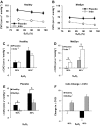Cyclooxygenase-derived vasoconstriction restrains hypoxia-mediated cerebral vasodilation in young adults with metabolic syndrome
- PMID: 24213610
- PMCID: PMC3920126
- DOI: 10.1152/ajpheart.00709.2013
Cyclooxygenase-derived vasoconstriction restrains hypoxia-mediated cerebral vasodilation in young adults with metabolic syndrome
Abstract
Poor cerebrovascular function in metabolic syndrome (MetSyn) likely contributes to elevated risk of cerebrovascular disease in this growing clinical population. Younger MetSyn adults without clinical evidence of cerebrovascular disease exhibit preserved hypercapnic vasodilation yet markedly impaired hypoxic vasodilation, but the mechanisms behind reduced hypoxic vasodilation are unknown. Based on data from rats, we tested the hypothesis that younger adults with MetSyn exhibit reduced cerebral hypoxic vasodilation due to loss of vasodilating prostaglandins. Middle cerebral artery velocity (MCAv) was measured with transcranial Doppler ultrasound in adults with MetSyn (n = 13, 33 ± 3 yr) and healthy controls (n = 15, 31 ± 2 yr). Isocapnic hypoxia was induced by titrating inspired oxygen to lower arterial saturation to 90% and 80% for 5 min each. Separately, hypercapnia was induced by increasing end-tidal CO2 10 mmHg above baseline levels. Cyclooxygenase inhibition (100 mg indomethacin) was conducted in a randomized double-blind, placebo controlled design. MCAv was normalized for group differences in blood pressure (healthy: 89 ± 2 mmHg vs. MetSyn: 102 ± 2 mmHg) as cerebrovascular conductance index (CVCi), and used to assess cerebral vasodilation. Hypoxia increased CVCi in both groups; however, vasodilation was ∼55% lower in MetSyn at SpO2 = 80% (P < 0.05). Indomethacin tended to decrease hypoxic vasodilation in healthy controls, and unexpectedly increased dilation in MetSyn (P < 0.05). In contrast to hypoxia, hypercapnia-mediated vasodilation was similar between groups, as was the decrease in vasodilation with indomethacin. These data indicate increased production of vasoconstrictor prostaglandins restrains hypoxic cerebral vasodilation in MetSyn, preventing them from responding appropriately to this important physiological stressor.
Keywords: cerebral blood flow; cyclooxygenase; metabolic syndrome.
Figures




Similar articles
-
Cerebral blood flow regulation in women across menstrual phase: differential contribution of cyclooxygenase to basal, hypoxic, and hypercapnic vascular tone.Am J Physiol Regul Integr Comp Physiol. 2016 Aug 1;311(2):R222-31. doi: 10.1152/ajpregu.00106.2016. Epub 2016 May 25. Am J Physiol Regul Integr Comp Physiol. 2016. PMID: 27225949 Free PMC article.
-
Impaired hypoxic cerebral vasodilation in younger adults with metabolic syndrome.Diab Vasc Dis Res. 2013 Mar;10(2):135-42. doi: 10.1177/1479164112448875. Epub 2012 Jul 2. Diab Vasc Dis Res. 2013. PMID: 22752659 Free PMC article. Clinical Trial.
-
Carbon dioxide-mediated vasomotion of extra-cranial cerebral arteries in humans: a role for prostaglandins?J Physiol. 2016 Jun 15;594(12):3463-81. doi: 10.1113/JP272012. Epub 2016 Apr 6. J Physiol. 2016. PMID: 26880615 Free PMC article. Clinical Trial.
-
Cerebrovascular reactivity is associated with maximal aerobic capacity in healthy older adults.J Appl Physiol (1985). 2013 May 15;114(10):1383-7. doi: 10.1152/japplphysiol.01258.2012. Epub 2013 Mar 7. J Appl Physiol (1985). 2013. PMID: 23471946 Free PMC article.
-
Cyclooxygenase inhibition abolishes age-related differences in cerebral vasodilator responses to hypercapnia.J Appl Physiol (1985). 2012 Jun;112(11):1884-90. doi: 10.1152/japplphysiol.01270.2011. Epub 2012 Mar 22. J Appl Physiol (1985). 2012. PMID: 22442028 Free PMC article.
Cited by
-
Cerebrovascular regulation in men and women: stimulus-specific role of cyclooxygenase.Physiol Rep. 2015 Jul;3(7):e12451. doi: 10.14814/phy2.12451. Physiol Rep. 2015. PMID: 26149282 Free PMC article.
-
Differential contribution of cyclooxygenase to basal cerebral blood flow and hypoxic cerebral vasodilation.Am J Physiol Regul Integr Comp Physiol. 2020 Feb 1;318(2):R468-R479. doi: 10.1152/ajpregu.00132.2019. Epub 2019 Dec 23. Am J Physiol Regul Integr Comp Physiol. 2020. PMID: 31868517 Free PMC article.
-
Adenosine receptor-dependent signaling is not obligatory for normobaric and hypobaric hypoxia-induced cerebral vasodilation in humans.J Appl Physiol (1985). 2017 Apr 1;122(4):795-808. doi: 10.1152/japplphysiol.00840.2016. Epub 2017 Jan 12. J Appl Physiol (1985). 2017. PMID: 28082335 Free PMC article.
-
Cerebral blood flow regulation in women across menstrual phase: differential contribution of cyclooxygenase to basal, hypoxic, and hypercapnic vascular tone.Am J Physiol Regul Integr Comp Physiol. 2016 Aug 1;311(2):R222-31. doi: 10.1152/ajpregu.00106.2016. Epub 2016 May 25. Am J Physiol Regul Integr Comp Physiol. 2016. PMID: 27225949 Free PMC article.
-
Insulin resistance is associated with lower arterial blood flow and reduced cortical perfusion in cognitively asymptomatic middle-aged adults.J Cereb Blood Flow Metab. 2017 Jun;37(6):2249-2261. doi: 10.1177/0271678X16663214. Epub 2016 Jan 1. J Cereb Blood Flow Metab. 2017. PMID: 27488909 Free PMC article.
References
-
- Coyle MG, Oh W, Petersson KH, Stonestreet BS. Effects of indomethacin on brain blood flow, cerebral metabolism, and sagittal sinus prostanoids after hypoxia. Am J Physiol Heart Circ Physiol 269: H1450–H1459, 1995 - PubMed
-
- Di Carlo A. Human and economic burden of stroke. Age Ageing 38: 4–5, 2009 - PubMed
-
- Erdos B, Miller AW, Busija DW. Impaired endothelium-mediated relaxation in isolated cerebral arteries from insulin-resistant rats. Am J Physiol Heart Circ Physiol 282: H2060–H2065, 2002 - PubMed
Publication types
MeSH terms
Substances
Grants and funding
LinkOut - more resources
Full Text Sources
Other Literature Sources
Medical

